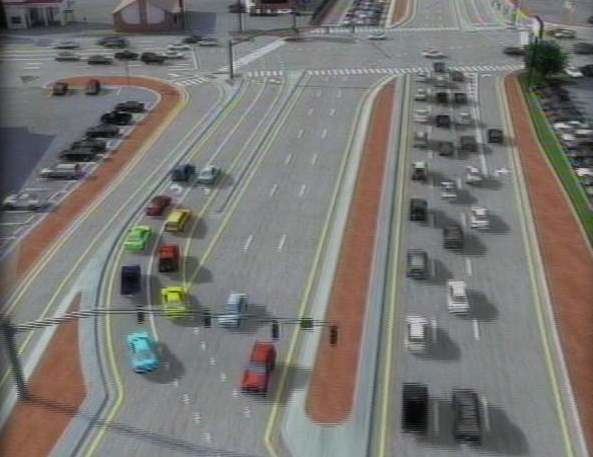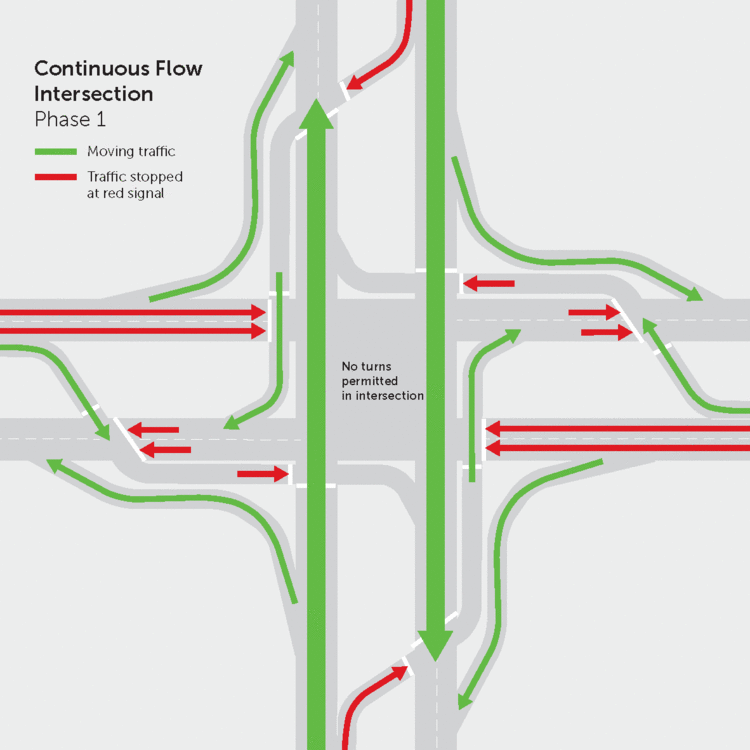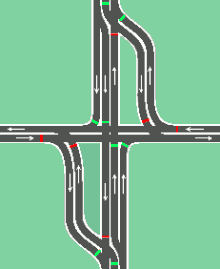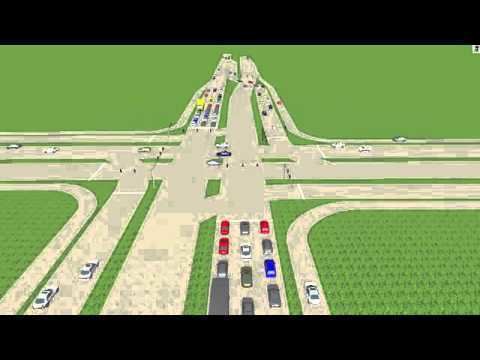 | ||
A continuous flow intersection (CFI), also called a crossover displaced left-turn (XDL or DLT), is an alternative design for an at-grade road junction. Vehicles attempting to turn across the opposing direction of traffic (left in right-hand drive jurisdictions; right in left-hand drive jurisdictions) cross before they enter the intersection. No left turn signal in the intersection is then necessary. Instead, vehicles traveling in both directions can proceed, including through vehicles and those turning right or left, when a generic traffic signal/stop sign permits.
Contents

History

A fly-over designed CFI interchange (separated grade) was invented by Francisco Mier. An intersection (at-grade) variant followed. Over 40 have been implemented since 2000. Mier patented his design, requiring a fee to obtain a license to the design. The patent expired in the United States on 15 October 2003.

This general configuration has appeared in different versions in various places, with the implementation of channelization in the United States since the 1950s, such as the Telegraph Road section of U.S. Route 24 in Michigan at Plymouth Road in Redford Charter Township, Michigan.
Usage


Listed in chronological order:
- Haddon Township, Audubon and Audubon Park, New Jersey, New Jersey Route 168 at Nicholson Road, is a hybrid one-leg continuous flow intersection that also employs a jughandle. 39.894161°N 75.091435°W / 39.894161; -75.091435
- Shirley, New York, opened in 1996, at the entrance to Dowling College. 40.826443°N 72.881042°W / 40.826443; -72.881042
- Accokeek, Maryland, opened in 2000, at the intersection of Routes 210 and 228. This is an example of a CFI-T, which is a T intersection containing one CFI leg. This junction also has characteristics of a continuous green T (or seagull) intersection. While neither of the routes is grade-separated, southbound through traffic on Route 210 is free-flowing. 38.664126°N 77.016928°W / 38.664126; -77.016928
- Baton Rouge, Louisiana, opened in March 2006, at the intersection of Airline Highway and Siegen Lane. 30.398914°N 91.054119°W / 30.398914; -91.054119
- Along Utah State Route 154 (Bangerter Highway) at
- 5400 South (SR-173) in Taylorsville, 40.652993°N 111.981339°W / 40.652993; -111.981339
- 4700 South in Taylorsville and West Valley City, 40.667596°N 111.981567°W / 40.667596; -111.981567
- 4100 South in West Valley City, 40.682132°N 111.981626°W / 40.682132; -111.981626
- 3500 South (SR-171) in West Valley City, opened in September 2007, 40.696629°N 111.980869°W / 40.696629; -111.980869
- 3100 South in West Valley City, 40.703918°N 111.980076°W / 40.703918; -111.980076
- Fenton, Missouri, opened October 2007, at the intersection of Highway 30 and Summit Drive/Gravois Bluffs Blvd. 38.504276°N 90.456995°W / 38.504276; -90.456995
- Miami Township, Montgomery County, Ohio, a two-leg CFI constructed in the spring of 2009, at the intersection of SR 741 and Miamisburg-Springboro Road/Austin Pike. 39.596709°N 84.229029°W / 39.596709; -84.229029
- Salt Lake County, Utah, in October 2009, the Utah Department of Transportation announced plans for five more continuous flow intersections along Bangerter Highway and Redwood Road (SR-68). As of March 11, 2011, four of them were in use.
- 13400 South and Bangerter Highway in Riverton, 40.507803°N 111.982747°W / 40.507803; -111.982747
- 7000 South and Bangerter Highway in West Jordan, 40.623983°N 111.976422°W / 40.623983; -111.976422
- 6200 South (Bennion Blvd) and Bangerter Highway in Taylorsville, 40.638581°N 111.976637°W / 40.638581; -111.976637
- W 5400 S (SR-173) and Redwood Road in Taylorsville, 40.653176°N 111.938802°W / 40.653176; -111.938802
- 6200 South (Bennion Blvd) and Redwood Road in Taylorsville, 40.638574°N 111.938824°W / 40.638574; -111.938824
- Natchez, Mississippi, opened January 2010 at the intersection of US 61 and Junkin Drive, designed by ABMB Engineers and constructed by MDOT. 31.528599°N 91.389213°W / 31.528599; -91.389213
- Lafayette, Louisiana, ground broke January 2010 at the intersection of US 167 (Johnston St.) and Camellia Boulevard. Estimated cost of $3.5 million. 30.193744°N 92.058622°W / 30.193744; -92.058622
- Loveland, Colorado, ground broke June 2010 at the intersection of US 34 (Eisenhower Blvd.) and Madison Ave. Estimated cost of $4 million. 40.407365°N 105.058764°W / 40.407365; -105.058764
- Orem, Utah, opened May 22, 2012 at the intersection of University Parkway and Sandhill Road, as part of the Interstate 15 CORE project. 40.275014°N 111.713445°W / 40.275014; -111.713445
- Durango, Colorado, at the intersection of US 160 and US 550. Estimated cost of $6.1 million. 37.268540°N 107.884992°W / 37.268540; -107.884992
- San Marcos, Texas, two CFIs were constructed. One is a single-leg CFI at the intersection of Loop 82 (Aquarena Springs Drive), Interstate 35's southbound frontage road and I-35's southbound-to-northbound Texas U-turn (29.893048°N 97.913367°W / 29.893048; -97.913367). The other, a two-leg CFI, is at the intersection of State Highway 80 (Hopkins Street), I-35's frontage roads and I-35's Texas U-turns (29.882639°N 97.921915°W / 29.882639; -97.921915). In both intersections, the displaced left turn lanes merge with the Texas U-turn lanes. The estimated cost for both CFIs is $4.7 million.
Operational details
Part of the delay at a typical, high-volume intersections is to accommodate left-turns; through-traffic must wait for the traffic turning left because it crosses the path of the through traffic. The continuous flow intersection moves the left-turn conflict out of the intersection and synchronizes it with the signal cycle of the intersecting road.
In the adjacent diagram, while the left/right traffic flows through the main intersection, the left-turn traffic crosses to the opposite side of the oncoming traffic a few hundred feet away. Doing this removes the crossing conflict. When the north/south through traffic is allowed through the main intersection, the north/south left-turn lanes are also allowed through the intersections as their paths are no longer crossing. All traffic flow is controlled by traffic signals as at a regular intersection.
The Louisiana DOTD article on the Baton Rouge CFI includes a particularly informative diagram of that intersection.
To reduce confusion regarding the left-turn lane, the left-turn lane and the straight-through lanes are usually separated by a concrete barrier or traffic island. This diagram shows the straight-through lanes offset by one lane through the intersection and are guided by lines painted through the intersection. But this is just a sample configuration; the lanes may be offset by more lanes or none at all.
Nonetheless, due to the provision of traffic between two directions of opposing traffic, some motorists tend to maintain an ongoing criticism of the intersection. Additionally, as in the case of the half-CFI in Accokeek, the offset left-turn traffic reenters the main traffic stream via a half-signal, requiring motorists to merge from a stop condition onto the higher-speed mainline. Motorists sometimes cite discomfort due to the speed differential, a known cause of accidents, though conflicts could be reduced through the provision of an adequate acceleration lane and merge area. The Accokeek, MD CFI also has notable inequalities in traffic flow depending upon the direction of travel.
This type of intersection can require a significant amount of right-of-way to implement (dependent upon the configuration), which is why the technique is not frequently used in urban areas. However, the amount of right-of-way necessary for construction and final operation is still typically less than that of an interchange. Additionally, as there is no grade separation involved, costs are considerably less than that of an interchange alternative.
Case studies
The redesign of the Redwood Road/6200 South intersection in Taylorsville, Utah cut emissions of carbon dioxide by 19 tons (17 tonnes) per year. Compared to the previous design, the redesign of the Bangerter Highway/3500 South intersection saves 3 1⁄2 minutes of travel time per vehicle and 800,000 U.S. gallons (3,000,000 liters) of fuel per year, and has 60% fewer accidents nearby; it also cost $20 million to $40 million less in construction costs than a grade-separated alternative.
Parallel-flow intersection
A parallel-flow intersection (PFI) is a variant similar to the CFI, patented in 2006. It arranges the left-turning traffic in a different manner; it is not displaced, instead turning left closer to the intersection onto a parallel roadway, to the left of oncoming traffic. This was first used in Haddon Township and Camden, New Jersey between New Jersey Route 168 and US Highway 130 at 39.90412°N 75.095812°W / 39.90412; -75.095812.
